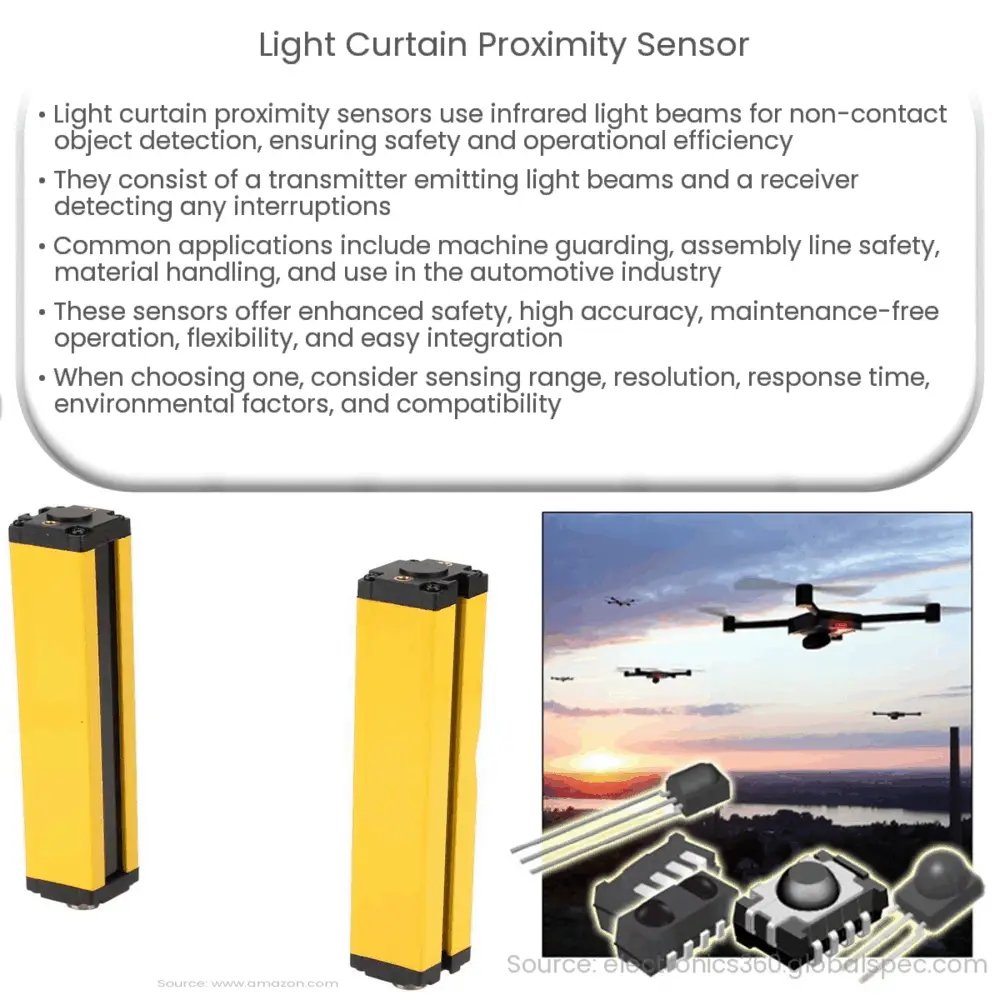Light curtain proximity sensors are non-contact devices that use infrared beams to detect objects, ensuring safety and efficiency in various industries.

Light Curtain Proximity Sensor: A Comprehensive Overview
Proximity sensors have become an integral part of modern-day automation, playing a crucial role in industrial processes and safety applications. Light curtain proximity sensors, in particular, have gained popularity in various sectors due to their ability to detect objects and ensure safety while maintaining operational efficiency. In this article, we will delve into the concept of light curtain proximity sensors, their working principles, applications, and benefits.
Understanding Light Curtain Proximity Sensors
Light curtain proximity sensors, also known as safety light curtains or optoelectronic devices, are non-contact sensing devices that use infrared light beams to detect the presence or absence of objects within a defined area. These sensors are typically composed of two main components: a transmitter and a receiver. The transmitter emits a series of parallel infrared light beams, while the receiver detects any interruptions in these beams caused by the presence of an object or person.
When an object or person breaks the light curtain, the sensor sends a signal to the control system, triggering a predetermined response such as stopping a machine, sounding an alarm, or initiating another safety measure. The fast response time and reliable object detection make light curtain proximity sensors an effective safety solution for various applications.
Working Principle of Light Curtain Proximity Sensors
The working principle of light curtain proximity sensors revolves around the concept of photoelectric detection. The transmitter emits multiple infrared light beams in a grid pattern, while the receiver continuously monitors the presence of these beams. When an object or person interrupts the light beams, the receiver registers a change in the received light pattern and sends a signal to the control system.
The sensing range and resolution of a light curtain proximity sensor depend on the number of light beams and the spacing between them. A higher number of beams and closer spacing result in greater accuracy and sensitivity. Most light curtain proximity sensors also feature a self-checking function that ensures the proper functioning of the device by continuously monitoring the transmitter and receiver for any faults or misalignments.
Applications of Light Curtain Proximity Sensors
Light curtain proximity sensors are widely used in diverse industries due to their ability to ensure safety while maintaining operational efficiency. Some common applications include:
- Machine guarding: These sensors are employed to protect operators and personnel from hazardous machinery by stopping the machine when a person enters the danger zone.
- Assembly line safety: In automated assembly lines, light curtain sensors are used to prevent workers from accessing dangerous areas or coming into contact with moving equipment.
- Material handling: Light curtain sensors can detect the presence of objects on conveyors, ensuring smooth and efficient material flow.
- Automotive industry: These sensors are used to safeguard workers from robotic arms and other automated equipment in automotive manufacturing plants.
Benefits of Light Curtain Proximity Sensors
Light curtain proximity sensors offer numerous advantages over traditional mechanical switches and other sensing technologies. Some of the key benefits include:
- Enhanced safety: By providing non-contact sensing, light curtain sensors prevent accidents and injuries by immediately stopping machinery or triggering safety measures when an object or person enters a hazardous zone.
- Maintenance-free operation: With no moving parts, light curtain sensors have a longer lifespan and require less maintenance compared to mechanical switches, reducing downtime and associated costs.
- High accuracy and reliability: The use of infrared light beams allows for precise object detection and minimal false triggering, ensuring consistent and reliable operation.
- Flexibility: Light curtain sensors can be customized to fit various applications, with adjustable sensing ranges, resolutions, and response times to meet specific requirements.
- Easy integration: Most light curtain sensors are compatible with standard industrial control systems, making them simple to implement into existing setups.
Selecting the Right Light Curtain Proximity Sensor
When choosing a light curtain proximity sensor, several factors should be taken into consideration to ensure optimal performance and safety. These include:
- Sensing range: Select a sensor with a suitable sensing range for the specific application. This range refers to the distance between the transmitter and receiver and should be adequate to cover the desired monitoring area.
- Resolution: The resolution of a light curtain sensor is determined by the number of light beams and the spacing between them. Higher resolution sensors provide better object detection and can detect smaller objects, but may be more expensive.
- Response time: Fast response times are crucial for safety applications, as they ensure that the sensor can quickly detect an object or person and trigger the appropriate safety measures. Consider the speed of the machinery and processes involved when selecting a sensor with an appropriate response time.
- Environmental factors: Consider the operating environment, including temperature, humidity, and potential exposure to dust, dirt, or moisture. Choose a light curtain sensor with suitable environmental ratings to ensure reliable operation.
- Compatibility: Verify that the selected light curtain sensor is compatible with the existing control system and meets any relevant safety standards or certifications.
Conclusion
Light curtain proximity sensors play a vital role in ensuring safety and efficiency in a wide range of industrial applications. By understanding their working principles, benefits, and selection criteria, businesses can optimize their processes while prioritizing the well-being of their personnel. As technology continues to advance, light curtain proximity sensors are poised to become even more sophisticated, providing enhanced safety measures and improved productivity across various sectors.

